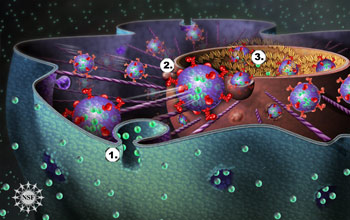News Release 07-100
New, More Direct Pathways from Outside of Cells to Cell Nuclei Discovered
Material outside of a cell can move into cell nucleus more easily than previously believed
August 10, 2007
This material is available primarily for archival purposes. Telephone numbers or other contact information may be out of date; please see current contact information at media contacts.
A team of Brooklyn College researchers has shattered a long-held belief that no direct pathway exists between material outside of a cell and the cell nucleus. (The cell is the smallest metabolically functional unit of life.)
It was already known that material outside of a cell can migrate into a cell. This occurs through processes known as endocytosis and phagocytosis, in which extracellular material is captured by a pinched-in segment of the cell membrane. This extracellular material then becomes trapped inside the resulting membrane-bound intracellular compartment, which is known as an endosome or phagosome.
It was also already known that material can migrate out of an endosome or phagosome and eventually enter the cell nucleus. But the Brooklyn College team has discovered that a phagosome and its contents can enter the cell's nucleus, where genetic information is stored and processed.
The team's discovery of the existence of direct pathways between extracellular material and cell nuclei will be published on August 10, 2007 in Cell Motility and the Cytoskeleton. The team was led by Ray Gavin and funded by the National Science Foundation (NSF).
Gavin says that these newly discovered direct pathways mean that "internalized material does not necessarily have to exit the phagosome before entering the nucleus." Therefore, his discovery means that "one less step is needed for extracellular material to get into the nucleus, and so it is far easier than previously thought for this material to get into the nucleus."
Eve Barak, an NSF program director, describes Gavin's discovery as "an amazing and potentially paradigm-changing observation," and predicts that it "will have an enormous impact on how scientists think about how cellular functions are regulated."
Gavin has only observed direct pathways from the extracellular environment to the nucleus in the one-celled protozoan Tetrahymena thermophila. But Gavin says that "other discoveries that were based on this protozoan were later shown to be almost global in their occurrence in the biological world." Therefore, these direct pathways may operate in other organisms as well.
The discovery of the pathways in the protozoan resulted from an observation made by Gavin about 10 years ago while simply watching cells through a microscope. "I am a patient and constant observer of living things," he says. "And I watch them all the time with no agenda in mind. Some people are window gazers. They stand in front of the window and just look. I do the same with cells."
During one of Gavin's agenda-less cell-watching sessions, he noticed phagosomes clustered around a cell's nucleus. "It made me wonder why the phagosomes were positioned in that way," Gavin said. Thereafter, Gavin periodically looked for this intriguing behavior again, and occasionally glimpsed it again.
But Gavin remained unable to systematically search for phagosome clusters around nuclei until he received NSF funding in 2006 to purchase a confocal microscope, which provides three dimensional views of the cell. Just like a person would eventually find a worm hidden in an apple by repeatedly slicing through the apple, Gavin found the intruiging phagosome behavior he sought by using the confocal microscope to repeatedly obtain views that sliced clear through the cells.
Specifically, the team tracked phagosomes carry extracellular material into the cell nuclei by introducing fluorescent latex beads into the area outside of the cell. They then observed the cells phagocytose (eat) the beads, which gradually moved to the nuclei. The arrival of the phagosomes and their loads at each nucleus was marked by the illumination of the nucleus by the beads. Similarly, the researchers also labeled the cellular membrane with a fluorescent dye, and then observed the pinched off, internalized membrane move to the nucleus.
"Biologists may now study the kinds of external molecules that can gain entry to the nucleus through these newly defined pathways and how these materials influence the nucleic material and its processes," said Gavin.
-NSF-
Media Contacts
Dick Sheridan, Brooklyn College, (718) 951-5882, email: rsheridan@brooklyn.cuny.edu
Lily Whiteman, NSF, (703) 292-8310, email: lwhitema@nsf.gov
Program Contacts
Eve Barak, NSF, (703) 292-7113, email: ebarak@nsf.gov
Principal Investigators
Dr. Ray Gavin, Brooklyn College, (718) 951-5715, email: rhgavin@brooklyn.cuny.edu
The U.S. National Science Foundation propels the nation forward by advancing fundamental research in all fields of science and engineering. NSF supports research and people by providing facilities, instruments and funding to support their ingenuity and sustain the U.S. as a global leader in research and innovation. With a fiscal year 2023 budget of $9.5 billion, NSF funds reach all 50 states through grants to nearly 2,000 colleges, universities and institutions. Each year, NSF receives more than 40,000 competitive proposals and makes about 11,000 new awards. Those awards include support for cooperative research with industry, Arctic and Antarctic research and operations, and U.S. participation in international scientific efforts.
Connect with us online
NSF website: nsf.gov
NSF News: nsf.gov/news
For News Media: nsf.gov/news/newsroom
Statistics: nsf.gov/statistics/
Awards database: nsf.gov/awardsearch/
Follow us on social
Twitter: twitter.com/NSF
Facebook: facebook.com/US.NSF
Instagram: instagram.com/nsfgov

